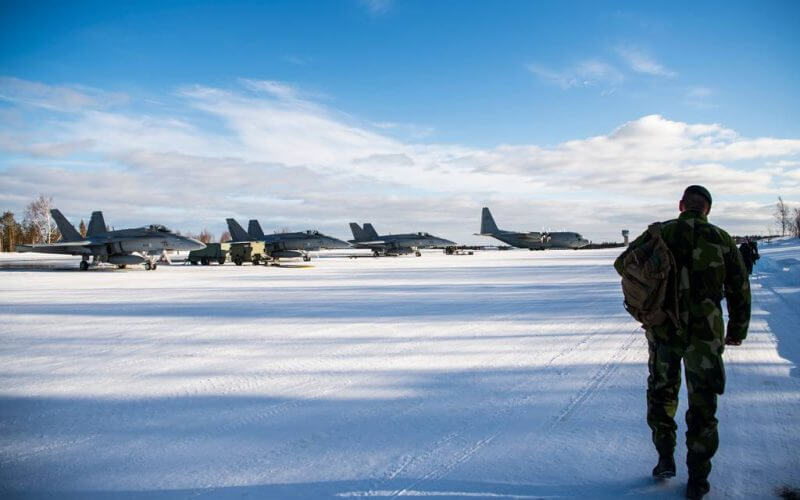America’s top general, Gen. Mark Milley, and senior Swedish officialswill open a major multinational exercise from Stockholm this Saturday as the Baltic Sea takes on a pivotal role in NATO’s northern defense calculus.
With Finland and Sweden’s NATO membership, which is still pending, the famously shallow body of water would essentially become a sea surrounded almost exclusively by alliance countries, with Russia maintaining its access through naval sites in Kaliningrad in the south and the St. Petersburg region at the far eastern end.
To send a signal to Russia of allied resolve, Sweden’s Defense Ministry wants a more robust NATO presence on the Baltic Sea, with naval vessels, and by air, through the sort of exercise kicking off June 5.
Sweden will host the annual large-scale BALTOPS exercise for the first time in its 50-year history. To show off amphibious, anti-submarine, gunnery and air-defense operations, 14 NATO allies, plus Sweden and Finland, will bring 45 ships, more than 75 aircraft, and about 7,000 personnel, according to the alliance.
Milley, the chairman of the Joint Chiefs of Staff, is slated to leave at the end of the week for Finland and Sweden as part of the next leg in his Europe trip. The four-star general said his meetings with senior officials there will be “symbolic of the support that the United States has for both these countries and the support that we have for their application to join NATO.”
All NATO members must approve the two Nordic nations’ bids to join the alliance, which were propelled by Russia’s invasion of Ukraine. Turkey has said it won’t allow their accession unless certain steps are taken, but NATO leaders are looking to the NATO summit in Spain in late June as the chance for the historic expansion.
The accession of Finland and Sweden, historically neutral nations, is expected to transform Europe’s security landscape for years to come. Their armed forces and geography would seriously complicate any further aggression Russia might want to try in the region, defense officials and national security experts say.
Sweden has “an incredible navy” with an air arm and ships like the Visby-class corvette that specialize in antisubmarine warfare and mine countermeasures, said retired Adm. James Foggo, the former commander of U.S. naval forces in Europe.
“They’re fast and made to fight in the fjords. The Scandinavians do that really well,” Foggo, now dean of the Navy League’s Center for Maritime Strategy, said of the distinctive-looking Visby class.
Finland and Sweden, despite their nonaligned status, participate in NATO’s planning and review process and have interoperability and cyber-defense arrangements with NATO. The U.S. signed bilateral defense cooperation agreements with both Sweden and Finland in 2016 and a threeway statement on boosting defense cooperation further in 2018.
In 2018, weeks after Russia staged Vostok, then its largest military exercise since the Soviet era, NATO conducted its massive Trident Juncture 18 exercise in Norway. Run by then-admiral Foggo, it included 50,000 troops and 70 ships from every NATO country, plus Finland and Sweden ― who hosted aircraft deployments and made their airspace available for operations.
“After Trident Juncture, I was convinced that Sweden and Finland do not need to be reformed in any way, shape or form. They can join tomorrow and be plug-and-play, just like they’d always been members of the alliance,” Foggo said.
Sweden’s Gotland, a strategically important Baltic Sea island, sits roughly 100 miles from Stockholm, but 200 miles from Kaliningrad, the headquarters of Russia’s Baltic Sea fleet, and 400 miles from Leningrad Naval Base in St. Petersburg.
Concerned about Russian encroachment in their waters, Sweden has reconstituted three heavy land brigades and returned a medium-range, surface-to-air missile system to the island in 2021. It again beefed up its presence there earlier this year in response to some Russian naval moves.
Along with the advantages offered by Sweden’s naval forces and Baltic Sea ports, Gotland has been made into “an unsinkable aircraft carrier,” U.S. Army Gen. Christopher Cavoli, said at his Senate hearing last week to become NATO’s supreme allied commander for Europe.
Sweden has acquired the Patriot long-range air-defense system and plans to double its defense budget, while Finland recently ordered 64 F-35 aircraft in a deal worth $10 billion. Finnish forces, Cavoli said, are “well-equipped, very well-trained, very quickly expandable, exercised very frequently, and absolutely expert in defending” its 800-mile border with Russia.
Their accession, Cavoli said, would create “almost geometric dilemmas” for Russia.










